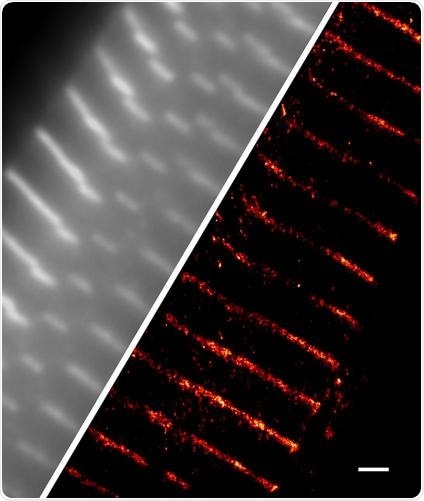An essential tool in biological research is fluorescence imaging, which enables the visualization of proteins in live and fixed cells. Conventional techniques, such as confocal microscopy, produce image resolutions that are limited by the microscope and by the diffraction properties of light to around 200 nm.
Novel Imaging Methods
Over the last two decades, many super-resolution microscopy (SRM) techniques have been developed – such as photoactivated localization microscopy (PALM), and direct stochastic optical reconstruction microscopy (dSTORM). These methods “cheat” the diffraction limit of light, and thus have resulted in massive resolution improvements of up to ten-fold.
Both PALM and dSTORM are single molecule imaging techniques involving the sequencing of individual fluorescent molecules and their repeated activation and deactivation using light of specific wavelengths. Following this, the localized positions of thousands of individual fluorophores are digitally reconstructed to form a “super-resolved” image.
Fluorescent Dyes for Fluorescence Imaging
It is important to note that the precise labeling of biomolecules, using bright fluorophores, is required in fluorescence imaging. A new range of rhodamine-based fluorescent dyes, known as Janelia Fluor® Dyes has been recently developed by Luke Lavis’ lab at the Janelia Research Campus, Howard Hughes Medical Institute (HHMI).
The Janelia Fluor®dyes are suitable to be used in conventional imaging techniques, such as confocal microscopy. These dyes are also suitable for use in SRM techniques, including dSTORM. Moreover, the development of photoactivatable derivatives enables their use in PALM.
Benefits of Janelia Fluor® Dyes
The advantage of Janelia Fluor® dyes is that they are extremely bright and photostable. More importantly, they are cell-permeable, thereby enabling live-cell intracellular imaging. These small molecule fluorophores are supplied as NHS esters, which allows for conjugation to an antibody of choice. What’s more, they are also compatible with self-labeling tag systems. Tocris has acquired a license for Janelia Fluor®dyes and their photoactivatable derivatives from HHMI, Janelia Research Campus, making the first commercially available in 2017.
The image displays a single isolated Wistar rat cardiomyocyte stained against α-actinin, thus displaying its periodic structure localized at the ends of sarcomeres (Z-discs). Wide-field fluorescence of Janelia Fluor™ 549 (left panel), prior to illumination with a 561 nm laser to induce photo-switching and produce a dSTORM super-resolution image (right panel).
Scale bar: 1 µm. Image kindly provided by Prof. Christian Soeller, University of Exeter, UK, acquired by Alex Clowsley and Anna Meletiou.

Fig 1. A single isolated Wistar rat cardiomyocyte stained against α-actinin. Scale bar - 1 µm. Image provided by Prof. Christian Soeller, University of Exeter, UK; acquired by Alex Clowsley and Anna Meletiou. Image credit: Tocris Bioscience
About Tocris Bioscience
Tocris Bioscience is your trusted supplier of high-performance life science reagents, including receptor agonists & antagonists, enzyme inhibitors, ion channel modulators, fluorescent probes & dyes, and compound libraries. Our catalog consists of over 4,500 research tools, covering over 400 protein targets enabling you to investigate and modulate the activity of numerous signaling pathways and physiological processes.
We have been working with scientists for over 30 years to provide the life science community with research standards, as well as novel and innovative research tools. We understand the need for researchers to trust their research reagents, which is why we are committed to supplying our customers with the highest quality products available, so you can publish with confidence.
Tocris is part of the protein sciences division of Bio-Techne, which also includes the best in class brands R&D Systems, Novus Biologicals, ProteinSimple, and Advanced Cell Diagnostics. Bio-Techne has united these brands to provide researchers with a full portfolio of research reagents, assays, and protein platforms. For more information on Bio-Techne and its brands, please visit bio-techne.com.
Sponsored Content Policy: News-Medical.net publishes articles and related content that may be derived from sources where we have existing commercial relationships, provided such content adds value to the core editorial ethos of News-Medical.Net which is to educate and inform site visitors interested in medical research, science, medical devices, and treatments.